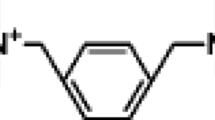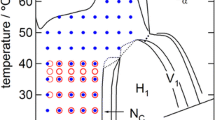Abstract
While lecithin alone can form spherical or ellipsoidal reverse micelles in oil, we found that urea can promote the growth of lecithin reverse worm-like micelles in oil. In a mixed system of urea and lecithin, the urea binds to the phosphate group of lecithin, thus reducing the interface curvature of the molecular assembly and inducing the formation of reverse worm-like micelles. The regions in which these micelles form increased with lecithin concentration. In addition, the zero-shear viscosity (η 0) of the reverse worm-like micelles rapidly increased upon the addition of urea, reaching a maximum of 2 million times the viscosity of n-decane. We examined the change in η 0 in detail by performing dynamic viscoelasticity measurements. Values for η 0 increased with urea concentration because the disentanglement time of reverse worm-like micelles increased with micellar growth.









Similar content being viewed by others
References
Scartazzini R, Luisi PL (1988) Organogels from lecithins. J Phys Chem 92:829–833
Schurtenberger P, Scartazzini R, Luisi PL (1989) Viscoelastic properties of polymerlike micelles. Rheol Acta 28:372–381
Luisi PL, Scartazzini R, Haering G, Schurtenberger P (1990) Organogels from water-in-oil microemulsions. Colloid Polym Sci 268:356–374
Angelico R, Palazzo G, Colafemmina G, Cirkel PA, Giustini M, Ceglie A (1998) Water diffusion and headgroup mobility in polymer-like reverse micelles: evidence of a sphere-to-rod-to-sphere transition. J Phys Chem B 102:2883–2889
Angelico R, Ceglie A, Olsson U, Palazzo G (2000) Phase diagram and phase properties of the system lecithin-water-cyclohexane. Langmuir 16:2124–2132
Shchipunov YA (2001) Lecithin organogel A micellar system with unique properties. Colloids Surf A 183:541–554
Aliotta F, Fontanella ME, Pieruccini M, Salvato G, Trusso S, Vasi C, Lechner RE (2002) Percolative phenomena in lecithin reverse micelles: the role of water. Colloid Polym Sci 280:193–202
Tung SH, Huang YE, Raghavan SR (2006) A new reverse wormlike micellar system: mixtures of bile salt and lecithin in organic liquids. J Am Chem Soc 128:5751–5756
Tung SH, Huang YE, Raghavan SR (2007) Contrasting effects of temperature on the rheology of normal and reverse wormlike micelles. Langmuir 23:372–376
Tung SH, Raghavan SR (2008) Strain-stiffening response in transient networks formed by reverse wormlike micelles. Langmuir 24:8405–8408
Bangham AD, Horne RW (1964) Negative staining of phospholipids and their structural modification by surface-active agents as observed in the electron microscope. J Mol Biol 8:660–668
Kratky O, Glatter O (1982) Small angle X-ray scattering. Academic, London
Shikata T, Hirata H, Kotaka T (1987) Micelle formation of detergent molecules in aqueous media: viscoelastic properties of aqueous cetyltrimethylammonium bromide solutions. Langmuir 3:1081–1086
Doi M, Edwards SF (1978) Dynamics of concentrated polymer systems. Part 1. Brownian motion in the equilibrium state. J Chem Soc Faraday Trans 2 74:1789–1801
Doi M, Edwards SF (1978) Dynamics of concentrated polymer systems. Part 2. Molecular motion under flow. J Chem Soc Faraday Trans 2 74:1802–1817
Doi M, Edwards SF (1978) Dynamics of concentrated polymer systems. Part 3. The constitutive equation. J Chem Soc Faraday Trans 2 74:1818–1832
Doi M, Edwards SF (1979) Dynamics of concentrated polymer systems. Part 4. Rheological properties. J Chem Soc Faraday Trans 2 75:38–54
Cates ME, Candau SJ (1990) Statics and dynamics of worm-like surfactant micelles. J Phys Condens Matter 2:6869–6892
Acknowledgment
This work was supported in part by the “High-Tech Research Center” project for private universities, a matching fund subsidy from the Ministry of Education, Culture, Sports, Science and Technology (MEXT) of Japan, 2007.
Author information
Authors and Affiliations
Corresponding author
Rights and permissions
About this article
Cite this article
Hashizaki, K., Chiba, T., Taguchi, H. et al. Highly viscoelastic reverse worm-like micelles formed in a lecithin/urea/oil system. Colloid Polym Sci 287, 927–932 (2009). https://doi.org/10.1007/s00396-009-2048-6
Received:
Revised:
Accepted:
Published:
Issue Date:
DOI: https://doi.org/10.1007/s00396-009-2048-6




